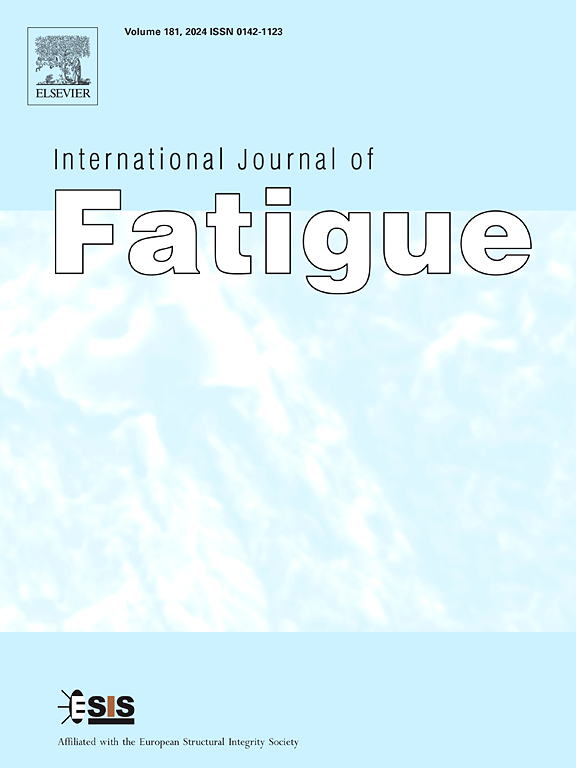Influence of acid environment on the fatigue behavior of short glass fiber polyamide 6/6.6 (35% wt.) composites
IF 5.7
2区 材料科学
Q1 ENGINEERING, MECHANICAL
引用次数: 0
Abstract
This study investigates the impact of a low-pH acidic aqueous solution on the fatigue behavior of short glass fiber-reinforced polyamide composites (PA6 and PA6.6, 35 % wt.). Mechanical tests were conducted under aging conditions (RH90, 60 °C) with fixed parameters (f = 1–3 Hz, R = 0.1), considering anisotropy with three orientations (0°, 45°, and 90°). A specialized chamber was developed for in-situ fatigue testing in an acid-heated solution. The study tracked mass and dimensions during aging and compared them with data from demineralized water. Results indicate that acid exposure significantly degrades the fiber–matrix interface, leading to increased fiber pullout and reduced mechanical integrity. PA6 composites exhibit better hydrolytic stability compared to PA6.6. This research provides critical insights into the durability of SFRP composites in acidic environments, relevant for automotive applications such as EGR (Exhaust Gas Recirculation) systems.
酸性环境对短玻璃纤维聚酰胺6/6.6 (35% wt.)复合材料疲劳性能的影响
本研究探讨了低ph酸性水溶液对短玻璃纤维增强聚酰胺复合材料(PA6和PA6.6, 35%重量)疲劳性能的影响。力学试验在固定参数(f = 1-3 Hz, R = 0.1)的老化条件(RH90, 60°C)下进行,考虑三个方向(0°,45°和90°)的各向异性。开发了一个专门用于酸加热溶液中原位疲劳试验的室。该研究追踪了老化过程中的质量和尺寸,并将它们与脱盐水的数据进行了比较。结果表明,酸暴露会显著降解纤维-基质界面,导致纤维拉出增加,机械完整性降低。与PA6.6相比,PA6复合材料具有更好的水解稳定性。这项研究为SFRP复合材料在酸性环境中的耐久性提供了重要的见解,与EGR(废气再循环)系统等汽车应用相关。
本文章由计算机程序翻译,如有差异,请以英文原文为准。
求助全文
约1分钟内获得全文
求助全文
来源期刊

International Journal of Fatigue
工程技术-材料科学:综合
CiteScore
10.70
自引率
21.70%
发文量
619
审稿时长
58 days
期刊介绍:
Typical subjects discussed in International Journal of Fatigue address:
Novel fatigue testing and characterization methods (new kinds of fatigue tests, critical evaluation of existing methods, in situ measurement of fatigue degradation, non-contact field measurements)
Multiaxial fatigue and complex loading effects of materials and structures, exploring state-of-the-art concepts in degradation under cyclic loading
Fatigue in the very high cycle regime, including failure mode transitions from surface to subsurface, effects of surface treatment, processing, and loading conditions
Modeling (including degradation processes and related driving forces, multiscale/multi-resolution methods, computational hierarchical and concurrent methods for coupled component and material responses, novel methods for notch root analysis, fracture mechanics, damage mechanics, crack growth kinetics, life prediction and durability, and prediction of stochastic fatigue behavior reflecting microstructure and service conditions)
Models for early stages of fatigue crack formation and growth that explicitly consider microstructure and relevant materials science aspects
Understanding the influence or manufacturing and processing route on fatigue degradation, and embedding this understanding in more predictive schemes for mitigation and design against fatigue
Prognosis and damage state awareness (including sensors, monitoring, methodology, interactive control, accelerated methods, data interpretation)
Applications of technologies associated with fatigue and their implications for structural integrity and reliability. This includes issues related to design, operation and maintenance, i.e., life cycle engineering
Smart materials and structures that can sense and mitigate fatigue degradation
Fatigue of devices and structures at small scales, including effects of process route and surfaces/interfaces.
 求助内容:
求助内容: 应助结果提醒方式:
应助结果提醒方式:


